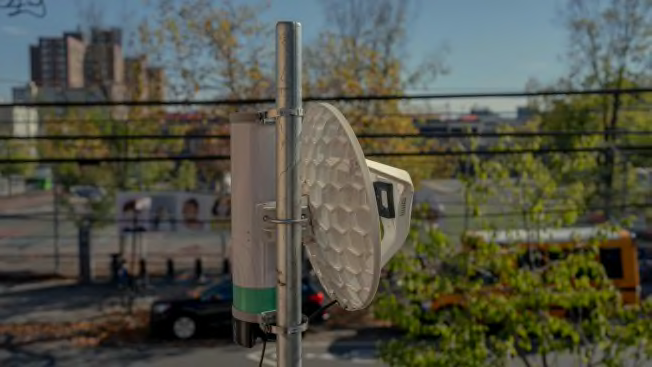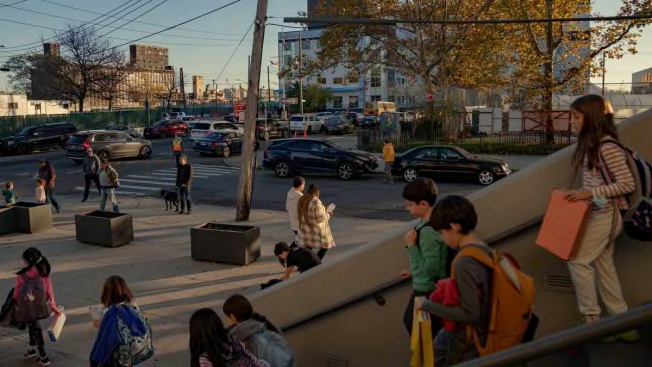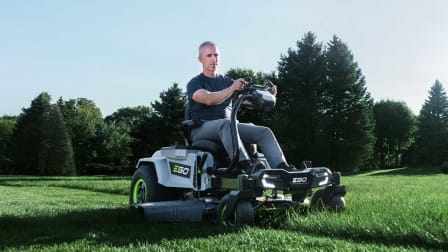Tracking Amazon: How Neighbors Are Monitoring Pollution From New Delivery Hubs
Residents are installing air quality and traffic sensors near schools and homes as more and more facilities open

For the past year, a pair of plain-looking buildings has been at the center of a simmering conflict in a close-knit waterfront community in New York City. They look like warehouses, with tall concrete walls, loading bays, and few windows. They sound like warehouses, emitting the rev of diesel engines and the chirps of reversing trucks. But by all accounts, they’re something very different.
The two newcomers to Brooklyn’s Red Hook neighborhood are hubs for Amazon’s growing last-mile delivery network. Unlike traditional warehouses, they’re bustling with around-the-clock activity, attracting convoys of cars, delivery vans, and semi-trucks to a neighborhood of narrow two-lane streets. Every day, shipments jostle through Red Hook’s crowded truck routes and make their way across New York, fulfilling Amazon’s promise of blistering-fast delivery.

Photo: Amir Hamja for The Guardian Photo: Amir Hamja for The Guardian
That’s why Red Hook residents, in collaboration with Consumer Reports and the Guardian, have installed air quality monitors and traffic-counting sensors near the new facilities. Environmental advocates have long called on warehouse operators to collect and publish traffic and air quality data, but since the companies haven’t done it, community members have stepped in.
Already the sensors show recurring periods of poor air quality in the past two months. Thirty percent of the time, tiny particulate matter—a major component of emissions from gas and diesel engines—was at a level the Environmental Protection Agency says can be harmful to groups sensitive to air pollution, such as people with asthma, but nonetheless labels “acceptable.” (Most of Red Hook has higher asthma rates than typical for New York City.) The rest of the time, air quality was in the “satisfactory” zone.
The sensors also picked up a decline in air quality in a span that coincided with the first two months of operation for the larger of the two Amazon facilities currently open in the neighborhood. Particulate levels were in the EPA’s “moderate” category 17 percent of the time in the first half of the monitoring period, and 45 percent of the time in the second half. Meanwhile, our vehicle-counting sensors also detected high levels of truck traffic on an important commercial corridor.
Over two months, air quality was moderately unhealthy 30% of the time
Air quality sensors:
Sensor 1
Sensor 2
100 (hourly PM2.5 AQI)
Air Quality Index
(AQI) above 50,
a moderate
health risk
50
0
17
Sept
24
1
Oct
8
15
22
29
5
Nov
Air quality sensors:
Sensor 1
Sensor 2
100 (hourly PM2.5 AQI)
Air Quality Index
(AQI) above 50,
a moderate
health risk
50
0
17
Sept
24
1
Oct
8
15
22
29
5
Nov
Air quality sensors:
Sensor 1
Sensor 2
100 (hourly PM2.5 AQI)
Air Quality Index
(AQI) above 50,
a moderate
health risk
50
0
17
Sept
24
1
Oct
8
15
22
29
5
Nov
Air quality sensors:
Sensor 1
Sensor 2
100 (hourly PM2.5 AQI)
Air Quality Index
(AQI) above 50,
a moderate
health risk
50
0
17
Sept
24
1
Oct
8
15
22
29
5
Nov
Air quality sensors:
Sensor 1
Sensor 2
100 (hourly PM2.5 AQI)
Air Quality Index
(AQI) above 50,
a moderate
health risk
50
0
17
Sept
24
1
Oct
8
15
22
29
5
Nov
Since this early data was gathered while Red Hook’s two Amazon delivery centers were already operating, it’s impossible to say whether these trends are directly connected to the new facilities. But they do show that Red Hook’s traffic and air quality levels are already worrying—and will probably deteriorate as more facilities open in the neighborhood.
“First of all, it’s too many trucks,” says Tiffiney Davis, executive director of the Red Hook Art Project, a nonprofit that organizes classes, workshops, and tutoring for underserved students in the neighborhood. “These trucks shouldn’t be in a predominantly residential area, sneaking up in areas they shouldn’t be on. They’re putting children and families in danger."

Photo: Amir Hamja for The Guardian Photo: Amir Hamja for The Guardian
In a statement, Amazon spokesperson Simone Griffin said the company “partners with community stakeholders” before choosing to open a facility in a new community. Asked whether Amazon tracks air quality or traffic patterns near its facilities, Griffin didn’t respond directly, pointing instead to Amazon’s pledge to achieve net-zero carbon emissions by 2040.
The situation in Red Hook is helping drive local and state legislation putting new restrictions on delivery facilities. These rules, if passed, could become a model for warehouse communities nationwide.
Small Neighborhood in a Big City
Hemmed in on three sides by water and on the fourth by the enormous Bronx-Queens Expressway, Red Hook is a quasi-island in south Brooklyn. Its low buildings and industrial waterfront make it feel suspended in time, and its relative quiet has long attracted residents looking for a small community in the big city.
Since Hurricane Sandy upended the neighborhood a decade ago, it has sprouted some shiny, expensive new condos. But old-timers, including residents of Brooklyn’s largest public housing development, still greet each other by name on the streets.
Warehouses in Brooklyn’s Red Hook neighborhood
Warehouses
Active last-mile facilities
Under construction
Land acquired
Schools,
daycares, and
public libraries
Van Brunt St.
Public
housing
Truck
routes
Parks
New York City
Manhattan
2,000 ft
Brooklyn
500 m
Warehouses
Active last-mile facilities
Under construction
Land acquired
Van Brunt St.
Truck
routes
Schools,
daycares, and
public libraries
Public
housing
Parks
New York City
Manhattan
2,000 ft
Brooklyn
500 m
Warehouses
Truck
routes
Brooklyn
Active last-mile facilities
Under construction
Van Brunt St.
Land acquired
Schools, daycares,
and public libraries
Public housing
East River
Parks
New York City
Manhattan
2,000 ft
Brooklyn
500 m
Warehouses
Truck
routes
Brooklyn
Active last-mile facilities
Van Brunt St.
Under construction
Land acquired
Schools, daycares,
and public libraries
Public housing
East River
Parks
New York City
Manhattan
2,000 ft
Brooklyn
500 m
Warehouses
Active last-mile facilities
Truck
routes
Brooklyn
Under construction
Land acquired
Van Brunt St.
Schools, daycares,
and public libraries
Public housing
East River
Parks
New York City
Manhattan
Brooklyn
2,000 ft
500 m
Red Hook’s industrial history planted the seeds for its new chapter as a warehousing hub. Two-thirds of Red Hook is zoned in such a way that last-mile operators can develop on it without asking special permission or notifying residents, according to an analysis by the Guardian and Consumer Reports. That’s how Amazon, UPS, and several commercial real estate companies first arrived, largely unnoticed.
“Right now, they are essentially unregulated,” says Alok Disa, a senior research and policy analyst at Earthjustice, a nonprofit legal organization. “The current zoning approach considers these massive e-commerce mega-warehouses to be the same as a traditional mom-and-pop warehouse that’s storing a bunch of furniture for a month or two.”
Residents and community leaders say they learned about the newcomers secondhand, rather than via formal outreach. “We went over and knocked on the door of the [construction] trailer,” says Catherine McBride, director of community building at Red Hook Initiative (RHI), a longtime neighborhood nonprofit. “That’s when we learned that it was Amazon.”
Amazon vehicles have added to the volume of trucks and vans constantly squeezing through neighborhood streets. Over the course of two months, a traffic sensor we installed on a main street counted nearly one truck per minute, on average, in the 11 o’clock hour. On one particularly busy day, the sensor detected nearly 2.5 passing trucks per minute between 11 and noon.
The minutes add up quickly: Our sensors captured passing trucks more than 3,900 times on an average weekday.

Photo: Amir Hamja for The Guardian Photo: Amir Hamja for The Guardian
Some warehouse developers promised that the new facilities would bring job opportunities for local residents, not just traffic. Amazon has occasionally set up job booths during events at the Red Hook Houses, the large public housing development. It’s an attractive proposition for a neighborhood with high unemployment and a large proportion of low-income residents.
Not all residents are receptive to the overtures. “They’ve offered some jobs, but Amazon is not known to be the best of employers,” says Tevina Willis, a resident of the Red Hook Houses and community organizing manager at RHI. The Guardian reported on hazardous conditions at a large Amazon warehouse in Staten Island in 2020, and this year, workers at that facility cited poor working conditions as one reason for organizing a historic workers’ union.
Convenience at a Cost
Recently, advocacy organizations and policymakers have taken note of what’s going on in Red Hook, assembling a suite of policy proposals that would put New York at the forefront of regulating last-mile warehousing. Lawmakers focused on the neighborhood because it’s become a testing ground for the unchecked expansion of last-mile delivery networks directly adjacent to residential areas.
“It’s an issue of economic justice,” says Jenny Zhang, chief of staff to Assemblymember Marcela Mitaynes, a Democrat whose district includes Red Hook. (Zhang left her role after being interviewed for this story.) “There’s an underlying understanding that some of the conveniences we experience in modern life come at a cost. When private industry cannot mitigate some of the worst impacts of business, we as a government have a responsibility to mitigate those impacts.”
Neighborhood advocates say it’s deeply unfair that Red Hook is playing host to the dense cluster of last-mile facilities, in part because it piles more safety and environmental risks onto years of neglect and environmental harm.
Several existing and planned sites are near the Red Hook Houses, the public housing development that’s home to about 6,000 people. Asthma rates among residents are well above average for New York City, and repairs to damage caused by Hurricane Sandy are still incomplete more than 10 years after the storm brought destructive floodwaters to the low-lying waterfront neighborhood.
“It’s always our under-resourced, underdeveloped areas in our communities where we’re noticing this pattern of these super-large facilities coming into the neighborhood,” says Willis, the RHI organizer who lives in the Red Hook Houses. “And they also don’t offer the community anything.”
In an investigation published last year, Consumer Reports and the Guardian found that Amazon opened the majority of its warehouses in neighborhoods of color, relative to the cities the facilities served. The warehouses were also in lower income neighborhoods than typical in the surrounding city, we found.
Griffin, the Amazon spokesperson, said the company is working to address Red Hook’s “most immediate needs.” For example, Amazon has donated to local schools, a senior center, a recreational league, and an artists’ group. Griffin also said the Red Hook facilities employ some people from the neighborhood, but would not share how many.
Four policy proposals are aimed at the last-mile issue: three in New York City and one at the state level. Together, they’re an unprecedented attempt to restrain companies like Amazon, UPS, and FedEx from opening polluting clusters of last-mile facilities without engaging with the communities that will host them, and without reporting on the traffic and air quality impacts they bring with them.
“This very much feels like a David and Goliath situation,” says New York City councilmember Alexa Avilés, who sponsored several of the city proposals, and whose district includes Red Hook. “[Amazon] is one of the most powerful companies in the world, and it generally gets what it wants.”
Asked about the cluster of facilities in Red Hook, Amazon’s Griffin said, “We’re always looking to locate our facilities as close as possible to our customers and employees. We also have a large customer and employee presence in Brooklyn.”
In September, Last Mile Coalition, a group of advocacy organizations that includes Earthjustice, submitted a proposal to change the city’s zoning rules. If adopted, it would require operators to get a special permit before opening a last-mile facility. The permitting process would require companies to share public estimates of new traffic and air quality impacts. The proposal also aims to prevent clusters of last-mile facilities like the one in Red Hook.
At the same time, members of New York City council are proposing bills that would require last-mile warehouses to get licenses from the city before they can operate—a complement to the zoning amendment—and require the city to redesign its network of truck routes and install air quality monitors on major roads, including at every adjacent park or playground.
Warehouses can be built without special permission in two-thirds of Red Hook
Warehouses
Active last-mile facilities
Under construction
Land acquired
Zoning allows
warehouse
development
2,000 ft
500 m
Warehouses
Active last-mile facilities
Zoning allows
warehouse
development
Under construction
Land acquired
2,000 ft
500 m
Warehouses
Active last-mile facilities
Zoning allows
warehouse
development
Under construction
Land acquired
East River
Brooklyn
2,000 ft
500 m
Warehouses
Active last-mile facilities
Zoning allows
warehouse
development
Under construction
Land acquired
East River
Brooklyn
2,000 ft
500 m
Warehouses
Active last-mile facilities
Zoning allows
warehouse
development
Under construction
Land acquired
East River
Brooklyn
2,000 ft
500 m
And Mitaynes, the assemblymember whose district includes Red Hook, sponsored a state bill that would change how medium and large warehouses are regulated across New York. It would implement an “indirect source review,” a type of environmental regulation that exists only in a few places in the U.S. Under the proposal, warehouse operators would have to report publicly on the truck and van traffic they create, and prove to the state that the traffic won’t lead to any new air quality standard violations. They would also have to take steps to mitigate the harmful effects of the traffic, such as by electrifying their delivery fleets.
The interventions are united by a common worry: that clusters of facilities will threaten residents—especially kids and seniors—going to and from schools, public parks, senior centers, and other community centers.
These concerns loom large at Basis Independent Brooklyn, a private school for students grade 1–12 that sits cater-corner from a year-old Amazon Fresh facility, and one short block from the Amazon facility being constructed just off the waterfront. Red Hook’s truck route separates the school from the neighborhood’s enormous park complex—large portions of which are soon to reopen after a decade of closure to detoxify the fields—interfering with the school’s raucous daily drop-off and pickup routine.
“As a crossing guard, I’m worried about the uptick in traffic,” says Jo Golfarb, director of communications at the school. “There needs to be a limit on how many of these facilities can be built in one neighborhood. Otherwise, it’s just insanity."

Photo: Amir Hamja for The Guardian Photo: Amir Hamja for The Guardian
To avoid dangerous run-ins with the new truck and van traffic, Basis moved its pickup and drop-off zone further away from the school, and it has considered moving its pickup and drop-off times to lessen the risk. Two other schools, a daycare, and a senior center also sit on the busy truck route.
For Willamae Boling, a research librarian who lives between the Red Hook Houses and the Amazon Fresh facility, the uptick in truck and van traffic spells danger. It’s one reason Boling started asking questions about the new facilities in the neighborhood.
“My dad was killed by a driver, and that reoriented my whole life,” Boling says. “I look at these and I only see the potential for someone to die. I think it’s very likely."
Methodology: We gathered the data for this article using traffic-counting instruments made by a Brooklyn company called Numina, and air quality monitors from PurpleAir.
@consumerreports Last-mile facilities help companies like Amazon or UPS get deliveries to consumers quickly—sometimes as fast as the same day. As more facilities open, residents are installing air quality and traffic sensors near schools and homes. Learn more at cr.org #lastmiledelivery #amazondelivery #pollution ♬ original sound - Consumer Reports



















